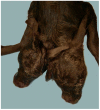Congenital Malformations in River Buffalo (Bubalus bubalis)
- PMID: 28208595
- PMCID: PMC5332930
- DOI: 10.3390/ani7020009
Congenital Malformations in River Buffalo (Bubalus bubalis)
Abstract
The world buffalo population is about 168 million, and it is still growing, in India, China, Brazil, and Italy. In these countries, buffalo genetic breeding programs have been performed for many decades. The occurrence of congenital malformations has caused a slowing of the genetic progress and economic loss for the breeders, due to the death of animals, or damage to their reproductive ability or failing of milk production. Moreover, they cause animal welfare reduction because they can imply foetal dystocia and because the affected animals have a reduced fitness with little chances of survival. This review depicts, in the river buffalo (Bubalus bubalis) world population, the present status of the congenital malformations, due to genetic causes, to identify their frequency and distribution in order to develop genetic breeding plans able to improve the productive and reproductive performance, and avoid the spreading of detrimental gene variants. Congenital malformations most frequently reported in literature or signaled by breeders to the Department of Veterinary Medicine and Animal Production of the University Federico II (Naples, Italy) in river buffalo are: musculoskeletal defects (transverse hemimelia, arthrogryposis, umbilical hernia) and disorders of sexual development. In conclusion this review put in evidence that river buffalo have a great variety of malformations due to genetic causes, and TH and omphalocele are the most frequent and that several cases are still not reported, leading to an underestimation of the real weight of genetic diseases in this species.
Keywords: congenital malformation; disorders of sexual development; genetic musculoskeletal defects; river buffalo.
Conflict of interest statement
The authors declare no conflict of interest.
Figures



Similar articles
-
Mitochondrial DNA Variability of Domestic River Buffalo (Bubalus bubalis) Populations: Genetic Evidence for Domestication of River Buffalo in Indian Subcontinent.Genome Biol Evol. 2015 Apr 20;7(5):1252-9. doi: 10.1093/gbe/evv067. Genome Biol Evol. 2015. PMID: 25900921 Free PMC article.
-
Bubalus bubalis: A Short Story.Front Vet Sci. 2020 Dec 1;7:570413. doi: 10.3389/fvets.2020.570413. eCollection 2020. Front Vet Sci. 2020. PMID: 33335917 Free PMC article. Review.
-
Haplotype diversity in the mitochondrial genome of the Egyptian river buffalo (Bubalus bubalis).Mitochondrial DNA B Resour. 2021 Jan 16;6(1):145-147. doi: 10.1080/23802359.2020.1852622. Mitochondrial DNA B Resour. 2021. PMID: 33537423 Free PMC article.
-
A review on breeding and genetic strategies in Iranian buffaloes (Bubalus bubalis).Trop Anim Health Prod. 2018 Apr;50(4):707-714. doi: 10.1007/s11250-018-1563-1. Epub 2018 Mar 9. Trop Anim Health Prod. 2018. PMID: 29524107 Review.
-
In Vitro Embryo Production in Buffalo Species (Bubalus bubalis).Methods Mol Biol. 2019;2006:179-190. doi: 10.1007/978-1-4939-9566-0_13. Methods Mol Biol. 2019. PMID: 31230281
Cited by
-
Sperm Global DNA Methylation (SGDM) in Semen of Healthy Dogs.Vet Sci. 2021 Mar 17;8(3):50. doi: 10.3390/vetsci8030050. Vet Sci. 2021. PMID: 33802963 Free PMC article.
-
De novo ZIC2 frameshift variant associated with frontonasal dysplasia in a Limousin calf.BMC Genomics. 2021 Jan 2;22(1):1. doi: 10.1186/s12864-020-07350-y. BMC Genomics. 2021. PMID: 33388042 Free PMC article.
-
Cytogenetic Analyses in Ewes with Congenital Abnormalities of the Genital Apparatus.Animals (Basel). 2019 Oct 10;9(10):776. doi: 10.3390/ani9100776. Animals (Basel). 2019. PMID: 31658596 Free PMC article.
-
An Unusual Case of Testicular Disorder in Sex Development of Arabian Mare (64,XX SRY-Negative).Animals (Basel). 2020 Oct 25;10(11):1963. doi: 10.3390/ani10111963. Animals (Basel). 2020. PMID: 33113813 Free PMC article.
-
Analysis of XX SRY-Negative Sex Reversal Dogs.Animals (Basel). 2020 Sep 16;10(9):1667. doi: 10.3390/ani10091667. Animals (Basel). 2020. PMID: 32947906 Free PMC article.
References
-
- FAO Water Buffaloes. [(accessed on 15 March 2016)]. Available online: http://www.fao.org/agriculture/dairy-gateway/milk-production/dairy-anima....
-
- Gholap P.N., Kale D.S., Sirothia A.R. Genetic diseases in cattle: A review. Res. J. Anim. Vet. Fish. Sci. 2014;2:24–33.
-
- Purohit G.N., Kumar P., Solanki K., Shekher C., Yadav S.P. Perspectives of fetal dystocia in cattle and buffalo. Vet. Sci. Dev. 2012;2:31–42. doi: 10.4081/vsd.2012.3712. - DOI
-
- Marcolongo-Pereira C., Schild A.L., Pereira-Soares M., Vargas S.F., Jr., Riet-Correa F. Congenital defects in ruminants in southern Brazil. Pesq. Vet. Bras. 2010;30:816–826. doi: 10.1590/S0100-736X2010001000003. - DOI
-
- Damé M.C.F., Riet-Correa F., Schild A.L. Hereditary diseases and congenital defects diagnosed in water buffalo (Bubalus bubalis) in Brazil. Pesq. Vet. Bras. 2013;33:831–839. doi: 10.1590/S0100-736X2013000700001. - DOI
Publication types
LinkOut - more resources
Full Text Sources
Other Literature Sources

